An Interpretable Hybrid Deep Learning Model for Molten Iron Temperature Prediction at the Iron-Steel Interface Based on Bi-LSTM and Transformer
Abstract
1. Introduction
- (1)
- Combined with deep learning technology, an interpretable hybrid deep learning model optimized by Optuna framework based on Bi-LSTM and Transformer is proposed for prediction of hot metal temperature drop.
- (2)
- The Catboost-RFECV algorithm is used for feature selection, identifying the most significant features that influence the temperature drop prediction.
- (3)
- SHAP (Shapley Additive Explanations) is used to analyze the interpretability of the deep learning model by quantitatively assessing the contribution of each input feature to the molten iron temperature drop prediction. This method provides clear insights into how each feature influences the model’s output, enhancing transparency and understanding of the model’s decision-making process.
- (4)
- This paper focuses on molten iron ladle temperature prediction, an area where there is limited existing research, especially compared to the more extensively studied temperature prediction for torpedo ladles, making our work relatively novel in this context.
- (5)
- Experiments are conducted using the molten iron ladle turnover dataset from Tangsteel to assess the model’s performance. The findings indicate that the proposed model demonstrates strong adaptability and feasibility in predicting molten iron temperature at the iron-steel interface, facilitating efficient, real-time, and reliable temperature forecasting.
2. Hot Metal Temperature Prediction Model
2.1. Feature Selection Approach
Catboost-RFECV
2.2. Optimization Algorithm
Optuna Optimization Framework
2.3. Construction of Optuna-Bi-LSTM-Transformer Model
2.3.1. Bi-LSTM
2.3.2. Transformer
- (1)
- Multi-head attention mechanism
- (2)
- Feed Forward Network
- (3)
- Residual connection and layer normalization
2.3.3. Optuna-Bi-LSTM-Transformer
- Feature window size optimization: Optuna is used to search for the optimal size of the input feature window. By adjusting the length of the input sequence, OPTUNA captures the most useful information in the time series for prediction.
- LSTM unit number optimization: Optuna is employed to determine the optimal number of cells in the Bi-LSTM layer. The first Bi-LSTM layer captures local features of the input sequence, while the second layer extracts global features.
- Embedding dimension optimization: Optuna searches for the embedding dimension to balance the representation power and computational complexity of the model, ensuring that high-quality feature representations are extracted.
- Multi-head attention number optimization: Optuna is utilized to search for the optimal number of heads (num_heads) and the dimension of each head (key_dim) in the Transformer.
| Algorithm 1: Optuna-Bi-LSTM-Transformer Algorithm |
| Input: Divided and normalized feature dataset |
| Output: Best Optuna-Bi-LSTM-Transformer hyperparameters (feature_window-best, lstm_units-best, embedding_dim-best, num_heads-best) |
| 1 Start the algorithm. |
| 2 Set the Optuna objective function as: |
| 3 Optuna-Bi-LSTM-Transformer(feature_window, lstm_units, embedding_dim, num_heads). |
| 4 Initialize variables: |
| 5 lstm_units_1, lstm_units_2, num_heads, dense_units, dropout_rate, time_steps, Fitness. |
| 6 Initialize best hyperparameters: |
| 7 lstm_units_1-best, lstm_units_2-best, num_heads-best, dense_units-best, dropout_rate-best, time_steps-best, Fitness-best. |
| 8 Set loop parameters: |
| 9 max_trials, current_trial. |
| 10 Start the loop: |
| 11 from current_trial = 1 to max_trials. |
| 12 Randomly sample hyperparameters using Optuna: |
| 13 Feature_window, lstm_units, embedding_dim, num_heads. |
| 14 Compute Fitness value: 15 Fitness = Optuna-Bi-LSTM-Transformer(feature_window, lstm_units, embedding_dim, num_heads). 16 Fitness is calculated using performance metrics such as MSE, RMSE, or MAE to evaluate prediction accuracy. |
| 17 Fitness = Optuna-Bi-LSTM-Transformer(feature_window, lstm_units, embedding_dim, num_heads). |
| 18 If Fitness > Fitness-best, 19 update the following: |
| 20 Fitness-best, feature_window-best, lstm_units-best, embedding_dim-best, num_heads-best. |
| 21 Output current trial results: |
| 22 current_trial, Fitness, feature_window, lstm_units, embedding_dim, num_heads. |
| 23 If early stopping conditions are met, output: |
| 24 ‘Early stopping condition met, exiting loop’ and break the loop. |
| 25 End the loop. |
| 26 Output the best hyperparameters: |
| 27 Feature_window-best, lstm_units-best, embedding_dim-best, num_heads-best. |
| 28 End the algorithm. |
2.4. Model Analysis Method
SHAP Interpretable Model
3. Experiment and Analysis
3.1. Experimental Setup
3.1.1. Description of Experimental Environment and Dataset
- (a)
- Experimental Environment:
- (b)
- Dataset Description
3.1.2. Baseline Model
3.1.3. Model Performance Evaluation Metrics
- (1)
- Coefficient of Determination (R2)
- (2)
- Mean Squared Error (MSE)
- (3)
- Root Mean Squared Error (RMSE)
- (4)
- Mean Absolute Percentage Error (MAPE)
- (5)
- Accuracy (Hit Rate)
3.1.4. Model Hyperparameter Configuration and Optimization
3.2. Data Processing and Feature Selection
3.2.1. Data Preprocessing
3.2.2. Feature Selection
3.3. Experimental Results and Comparison
3.3.1. Hyperparameter Analysis of the Optuna-Transformer-Bi-LSTM Network Model
3.3.2. Ablation Study
3.3.3. The Simulation Results of KR Station Entrance Temperature
3.3.4. SHAP-Based Model Explainability Analysis
- (1)
- Global Explanation
- (2)
- SHAP interaction analysis
- (3)
- Partial explanation
3.3.5. Analysis and Discussion
4. Conclusions
Author Contributions
Funding
Data Availability Statement
Acknowledgments
Conflicts of Interest
Appendix A. Model Architecture and Hyperparameters
| Model | Parameter | Numeric Value |
| Optuna-Transformer-Bi-LSTM | Embedding Dimension | 64 |
| Feature Window Size | 20 | |
| Number of LSTM Units | 128 | |
| Dropout | 0.2 | |
| Num_heads | 8 | |
| key_dim | 64 | |
| Learning rate | CosineDecay scheduling | |
| Weight_decay | 0.0002 | |
| Patience | 10 | |
| Factor | 0.5 | |
| Batch size | 25 | |
| Epochs | 50 | |
| Validation_split | 0.2 | |
| Transformer-Bi-LSTM | Embedding Dimension | 32 |
| Number of LSTM Units | 128 | |
| Dropout | 0.1 | |
| Num_heads | 4 | |
| key_dim | 64 | |
| Learning rate | CosineDecay scheduling | |
| Weight_decay | 0.0001 | |
| Patience | 10 | |
| Factor | 0.5 | |
| Batch size | 25 | |
| Epochs | 50 | |
| Validation_split | 0.2 | |
| Feature Window Size | 25 | |
| Transformer-LSTM | Number of LSTM Units | 64 |
| Learning rate | 0.01 | |
| Batch size | 32 | |
| Epochs | 14 | |
| Number of Transformer blocks | 2 | |
| Num_heads | 4 | |
| Key_dim | 32 | |
| Dropout | 0.1 | |
| Time_steps | 10 | |
| Embedding_activation | relu | |
| Optuna-Transformer | Activation | Adam |
| Dropout | 0.1 | |
| Batch size | 35 | |
| Num_blocks | 3 | |
| Epochs | 40 | |
| Validation_split | 0.3 | |
| Num_heads | 8 | |
| Dense_dim | 64 | |
| Embed_dim | 32 | |
| Transformer | Activation | Adam |
| Dropout | 0.1 | |
| Batch size | 32 | |
| Num_blocks | 3 | |
| Epochs | 36 | |
| Validation_split | 0.2 | |
| Num_heads | 4 | |
| Dense_dim | 64 | |
| Embed_dim | 32 | |
| Optuna-Bi-LSTM | Activation | Adam |
| Dropout | 0.1 | |
| The number of neurons in the LSTM layer | 64 | |
| Learning rate | 0.001 | |
| Batch size | 25 | |
| Epochs | 7 | |
| Bi-LSTM | Activation | Adam |
| Dropout | 0.1 | |
| The number of neurons in the LSTM layer | 64 | |
| Learning rate | 0.001 | |
| Batch size | 20 | |
| Epochs | 9 | |
| LSTM | Activation | Tanh |
| LSTM Number of layers | 2 | |
| Dropout | 0.2 | |
| Learning rate | 0.001 | |
| Batch size | 32 | |
| Epochs | 100 |
References
- Li, X.; Sun, W.; Zhao, L.; Cai, J. Material metabolism and environmental emissions of BF-BOF and EAF steel production routes. Miner. Process. Extract. Metall. Rev. 2018, 39, 50–58. [Google Scholar] [CrossRef]
- Wang, Z.L.; Bao, Y.P. New steelmaking process based on clean deoxidation technology. Int. J. Miner. Metall. Mater. 2024, 31, 1249–1262. [Google Scholar] [CrossRef]
- Durdán, M.; Terpák, J.; Laciak, M.; Kacur, J.; Flegner, P.; Tréfa, G. Hot metal temperature prediction during desulfurization in the ladle. Metals 2024, 14, 1394. [Google Scholar] [CrossRef]
- Zhao, J.; Li, X.; Liu, S.; Wang, K.; Lyu, Q.; Liu, E. Prediction of hot metal temperature based on data mining. High Temp. Mater. Process. 2021, 40, 87–98. [Google Scholar]
- He, F.; He, D.-f.; Xu, A.-j.; Wang, H.-b.; Tian, N.-Y. Hybrid model of molten steel temperature prediction based on ladle heat status and artificial neural network. J. Iron Steel Res. Int. 2014, 21, 181–190. [Google Scholar] [CrossRef]
- Song, X.; Meng, Y.; Liu, C.; Yang, Y.; Song, D. Prediction of Molten Iron Temperature in the Transportation Process of Torpedo Car. ISIJ Int. 2021, 61, 1899–1907. [Google Scholar] [CrossRef]
- Zhang, X.; Kano, M.; Matsuzaki, S. Ensemble pattern trees for predicting hot metal temperature in blast furnace. Comput. Chem. Eng. 2019, 121, 442–449. [Google Scholar] [CrossRef]
- Su, X.; Zhang, S.; Yin, Y.; Xiao, W. Prediction model of hot metal temperature for blast furnace based on improved multi-layer extreme learning machine. Int. J. Mach. Learn. Cybern. 2019, 10, 2739–2752. [Google Scholar] [CrossRef]
- Liu, D.; Tang, J.; Chu, M.; Xue, Z.; Shi, Q.; Feng, J. Hot Metal Temperature Prediction Technique Based on Feature Fusion and GSO-DF. ISIJ Int. 2024, 64, 1881–1892. [Google Scholar] [CrossRef]
- Díaz, J.; Fernández, F.J.; Prieto, M.M. Hot Metal Temperature Forecasting at Steel Plant Using Multivariate Adaptive Regression Splines. Metals 2019, 10, 41. [Google Scholar] [CrossRef]
- Yang, G.; Xu, H. A Residual Bi-LSTM Model for Named Entity Recognition. IEEE Access 2020, 8, 227710–227718. [Google Scholar] [CrossRef]
- Zhang, Y.; Yang, J. Chinese NER using lattice LSTM. arXiv 2018, arXiv:1805.02023. [Google Scholar]
- Chiu, J.P.C.; Nichols, E. Named entity recognition with bidirectional LSTM-CNNs. Trans. Assoc. Comput. Linguist. 2016, 4, 357–370. [Google Scholar] [CrossRef]
- Pinasthika, K.; Laksono, B.S.P.; Irsal, R.B.P.; Shabiyya, S.H.; Yudistira, N. SparseSwin: Swin transformer with sparse transformer block. Neurocomputing 2024, 580, 127433. [Google Scholar] [CrossRef]
- Yao, D.; Shao, Y. A data efficient transformer based on Swin Transformer. Vis. Comput. 2023, 40, 2589–2598. [Google Scholar] [CrossRef]
- Shih, Y.-J.; Wu, S.-L.; Zalkow, F.; Müller, M.; Yang, Y.H. Theme transformer: Symbolic music generation with theme-conditioned transformer. IEEE Trans. Multimed. 2022, 25, 3495–3508. [Google Scholar] [CrossRef]
- Akiba, T.; Sano, S.; Yanase, T.; Ohta, T.; Koyama, M. Optuna: A next-generation hyperparameter optimization framework. In Proceedings of the 25th ACM Sigkdd International Conference on Knowledge Discovery & Data Mining, Anchorage, AK, USA, 4–8 August 2019; pp. 2623–2631. [Google Scholar]
- Shekhar, S.; Bansode, A.; Salim, A. A Comparative study of Hyper-Parameter Optimization Tools. In Proceedings of the 2021 IEEE Asia-Pacific Conference on Computer Science and Data Engineering (CSDE), Brisbane, QLD, Australia, 8–10 December 2021; pp. 1–6. [Google Scholar]
- Koushik, A.; Manoj, M.; Nezamuddin, N. Explaining deep learning-based activity schedule models using SHapley Additive exPlanations. Transp. Lett. 2024, 1–16. [Google Scholar] [CrossRef]
- Su, R.; Liu, X.; Wei, L. MinE-RFE: Determine the optimal subset from RFE by minimizing the subset-accuracy–defined energy. Brief. Bioinform. 2020, 21, 687–698. [Google Scholar] [CrossRef]
- Zhou, X.; Wen, H.; Zhang, Y.; Xu, J.; Zhang, W. Landslide susceptibility mapping using hybrid random forest with GeoDetector and RFE for factor optimization. Geosci. Front. 2021, 12, 101211. [Google Scholar] [CrossRef]
- Benjamin, K.J.M.; Katipalli, T.; Paquola, A.C.M.; Robinson, P. dRFEtools: Dynamic recursive feature elimination for omics. Bioinformatics 2023, 39, btad513. [Google Scholar] [CrossRef]
- Yue, G. Screening of lung cancer serum biomarkers based on Boruta-shap and RFC-RFECV algorithms. J. Proteom. 2024, 301, 105180. [Google Scholar] [CrossRef]
- Shi, K.; Shi, R.; Fu, T.; Lu, Z.; Zhang, J. A Novel Identification Approach Using RFECV–Optuna–XGBoost for Assessing Surrounding Rock Grade of Tunnel Boring Machine Based on Tunneling Parameters. Appl. Sci. 2024, 14, 2347. [Google Scholar] [CrossRef]
- Fu, B.; Liang, Y.; Lao, Z.; Sun, X.; Li, S.; He, H.; Sun, W.; Fan, D. Quantifying scattering characteristics of mangrove species from Optuna-based optimal machine learning classification using multi-scale feature selection and SAR image time series. Int. J. Appl. Earth Obs. Geoinf. 2023, 122, 103446. [Google Scholar] [CrossRef]
- Li, Y.; Cao, Y.; Yang, J.; Wu, M.; Yang, A.; Li, J. Optuna-DFNN: An Optuna framework driven deep fuzzy neural network for predicting sintering performance in big data. Alex. Eng. J. 2024, 97, 100–113. [Google Scholar] [CrossRef]
- Wakjira, T.G.; Alam, M.S. Peak and ultimate stress-strain model of confined ultra-high-performance concrete (UHPC) using hybrid machine learning model with conditional tabular generative adversarial network. Appl. Soft Comput. 2024, 154, 111353. [Google Scholar] [CrossRef]
- Yang, L.; Lei, J.; Cheng, M.; Ding, Z.; Li, S.; Zeng, Z. Memristor-based circuit design of Bi-LSTM network. Neural Netw. 2025, 181, 106780. [Google Scholar] [CrossRef]
- Kulshrestha, A.; Krishnaswamy, V.; Sharma, M. Bayesian Bi-LSTM approach for tourism demand forecasting. Ann. Tour. Res. 2020, 83, 102925. [Google Scholar] [CrossRef]
- Wei, J.; Liao, J.; Yang, Z.; Wang, S.; Zhao, Q. Bi-LSTM with Multi-Polarity Orthogonal Attention for Implicit Sentiment Analysis. Neurocomputing 2020, 383, 165–173. [Google Scholar] [CrossRef]
- Ekvall, M.; Truong, P.; Gabriel, W.; Wilhelm, M.; Käll, L. Prosit Transformer: A transformer for Prediction of MS2 Spectrum Intensities. J. Proteome Res. 2022, 21, 1359–1364. [Google Scholar] [CrossRef] [PubMed]
- Gao, L.; Zhang, J.; Yang, C.; Zhou, Y. Cas-VSwin transformer: A variant swin transformer for surface-defect detection. Comput. Ind. 2022, 140, 103689. [Google Scholar] [CrossRef]
- Li, Y.; Ge, L.; Jiang, M. Fine-grained personalized federated learning via transformer in the transformer framework. Knowl-Based Syst. 2024, 301, 112276. [Google Scholar] [CrossRef]
- Vaswani, A.; Shazeer, N.; Parmar, N.; Uszkoreit, J.; Jones, L.; Gomez, A.N.; Kaiser, L.; Polosukhin, I. Attention Is All You Need. arXiv 2017, arXiv:1706.03762. [Google Scholar]
- Khan, A.; Lee, B. DeepGene Transformer: Transformer for the gene expression-based classification of cancer subtypes. Expert Syst. Appl. 2023, 226, 120047. [Google Scholar] [CrossRef]
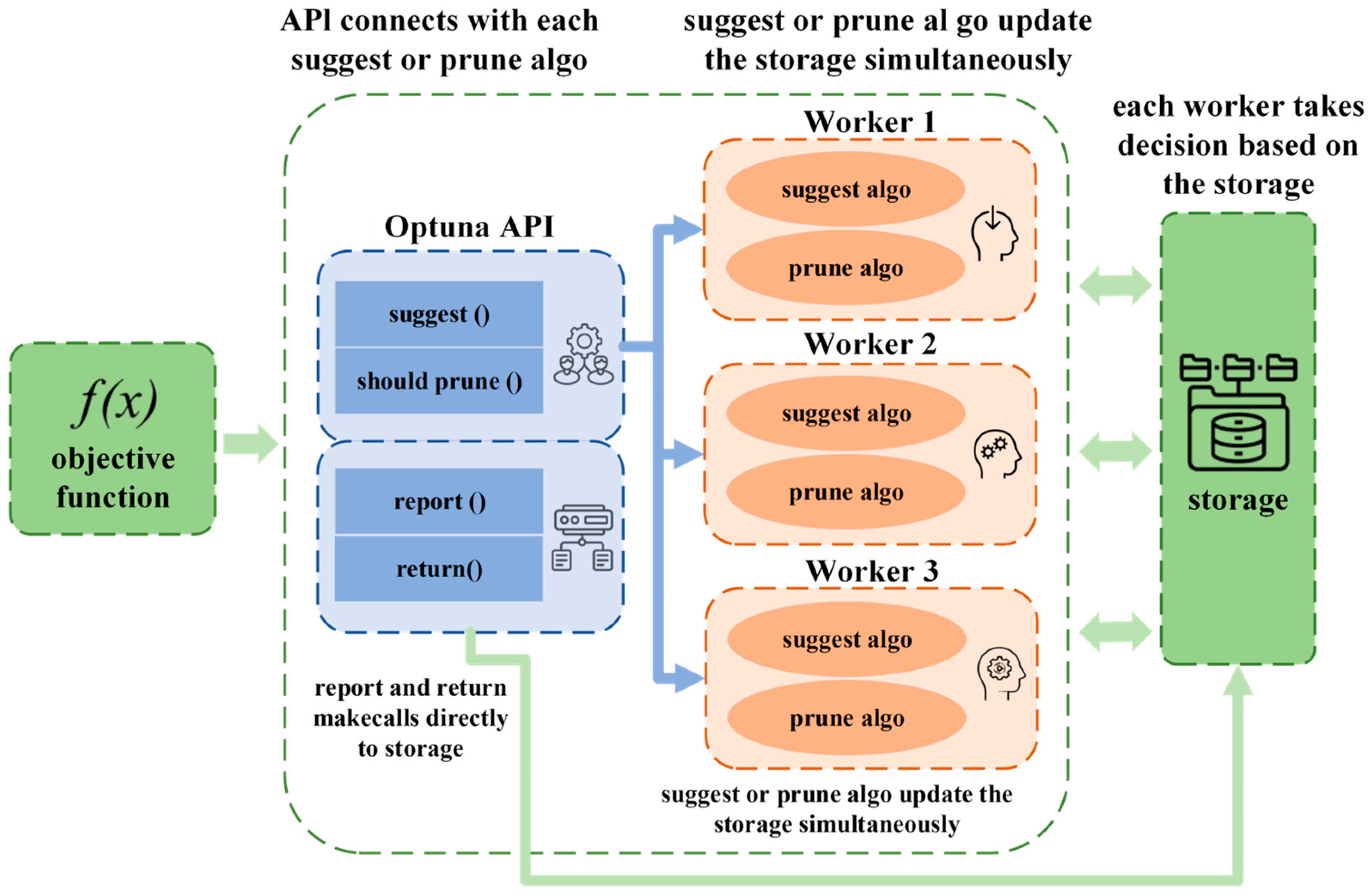

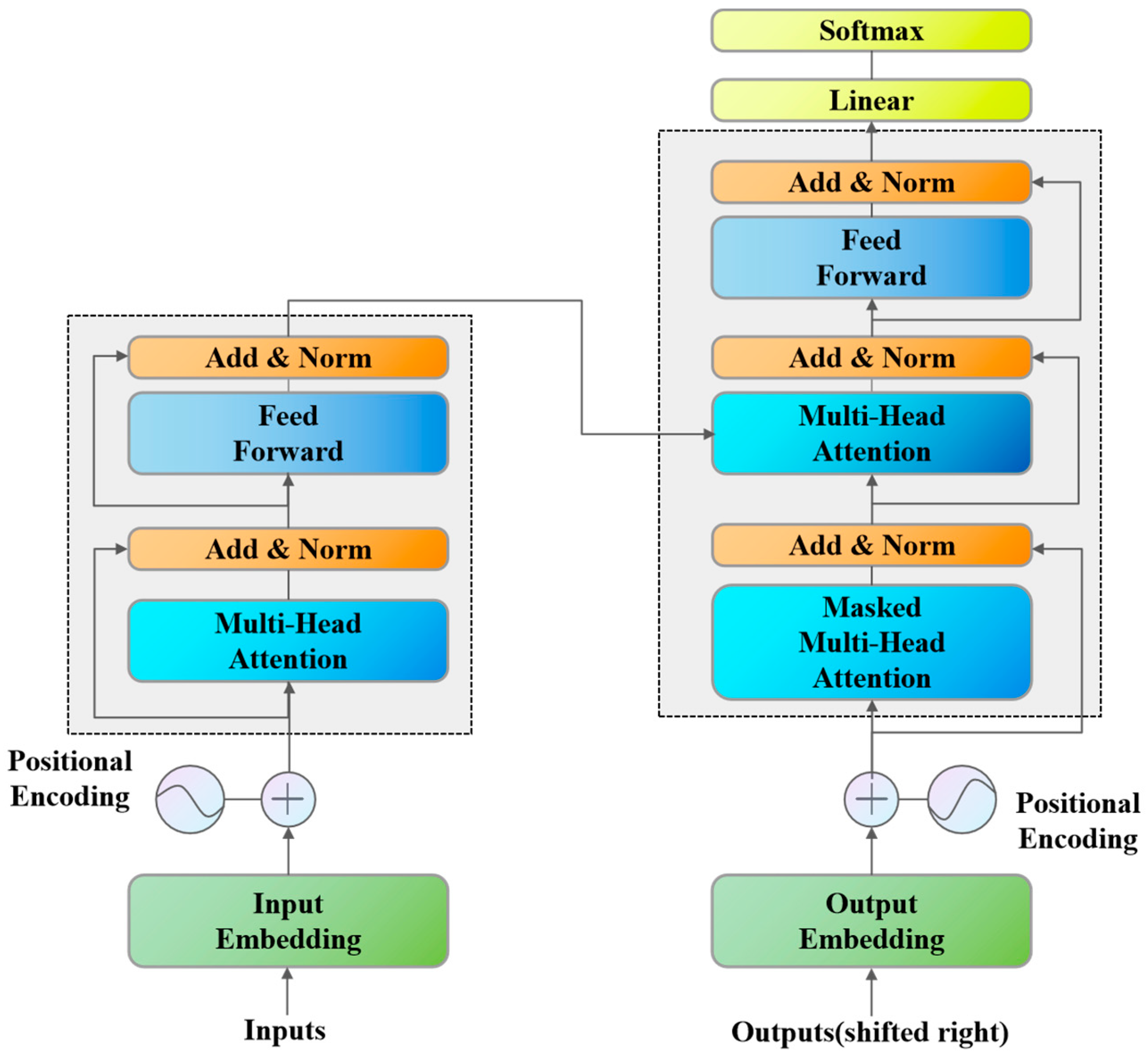
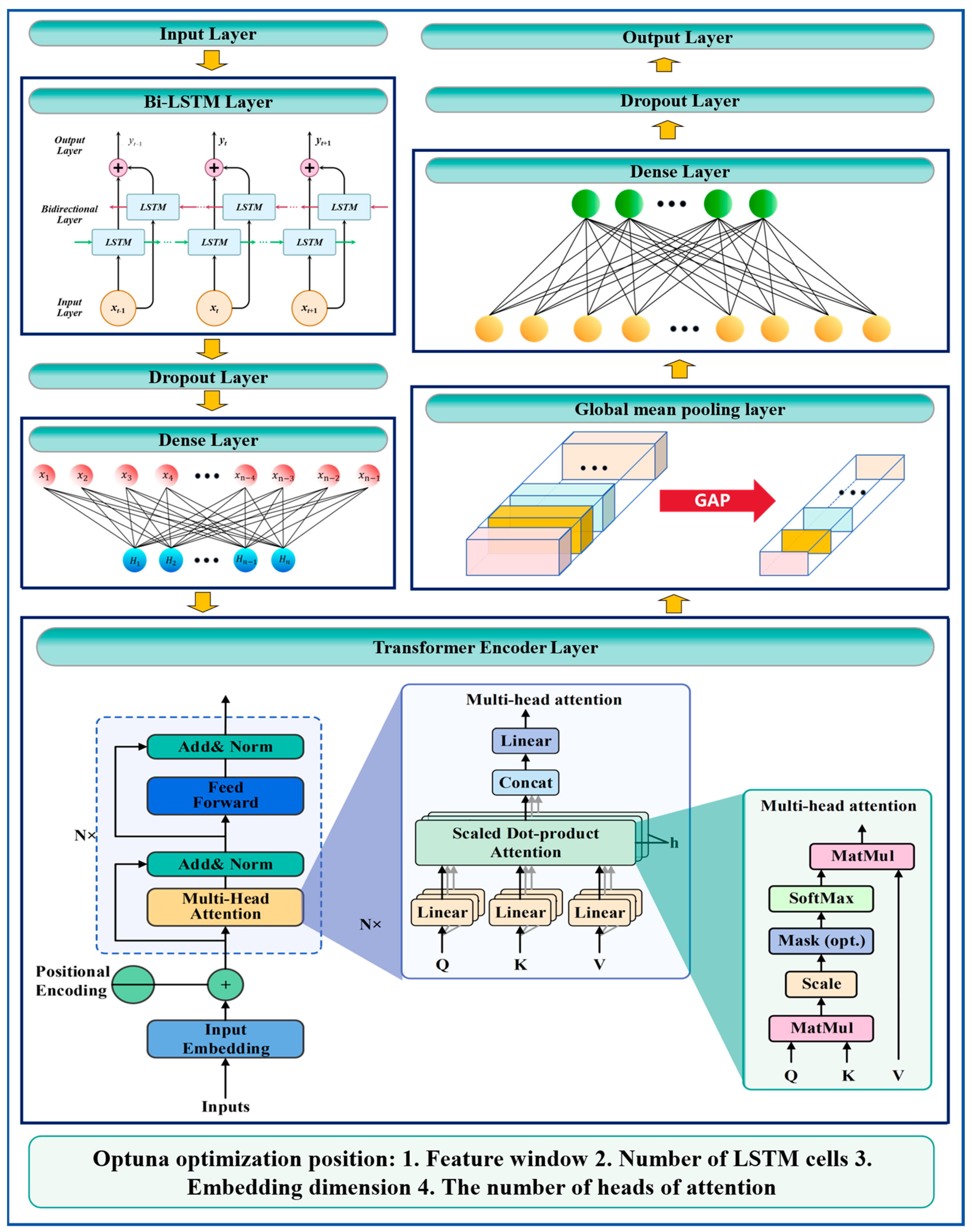

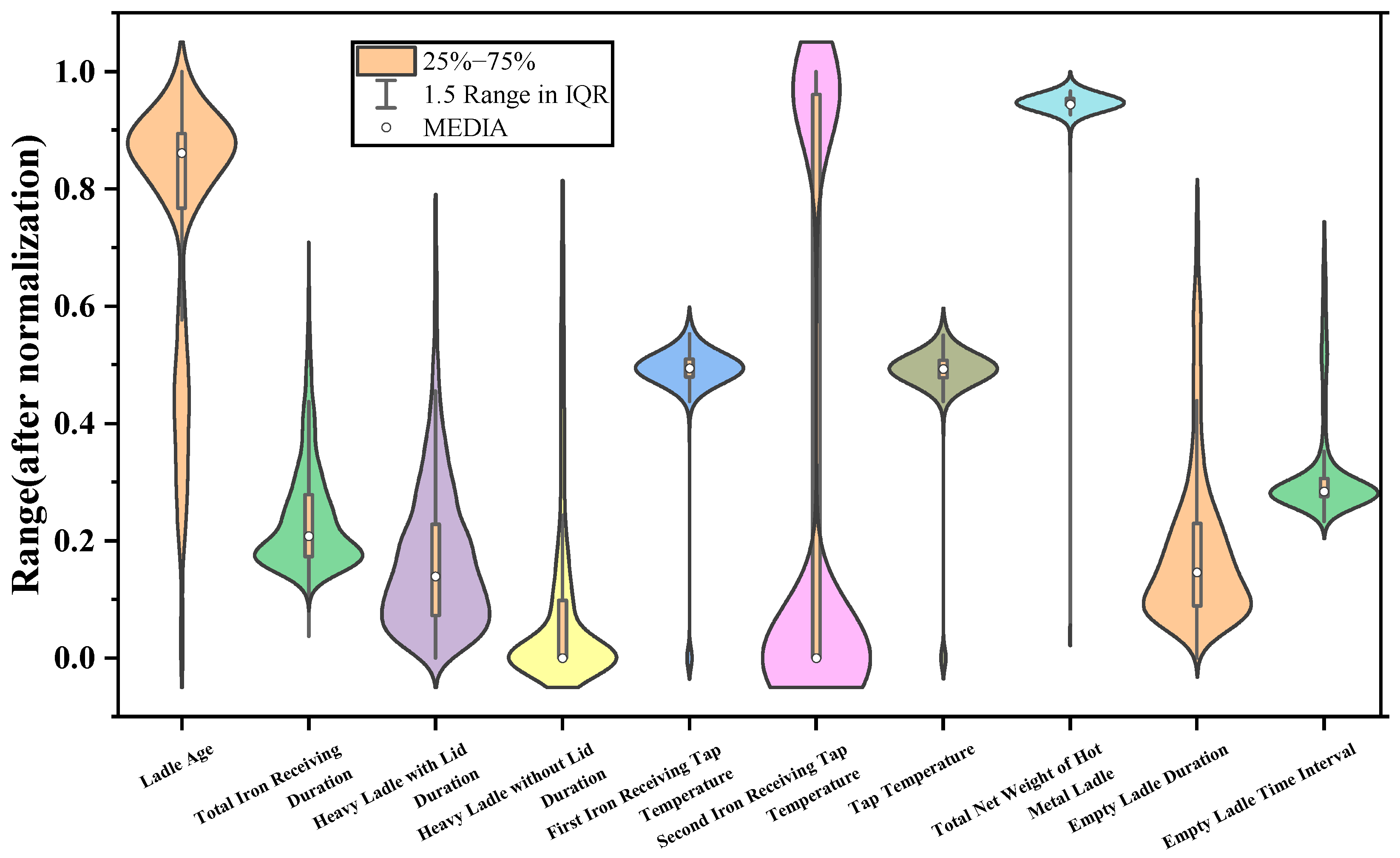
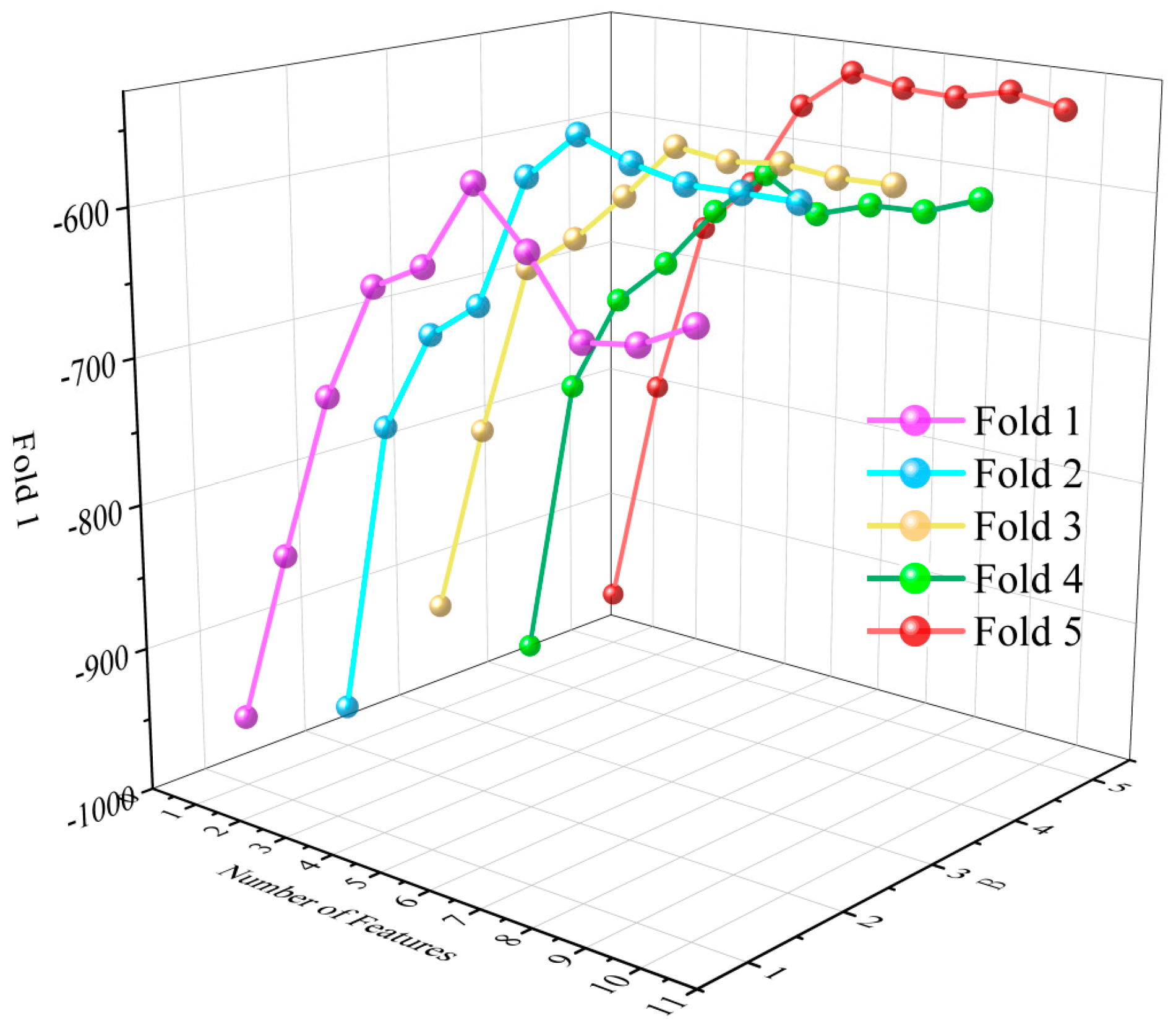

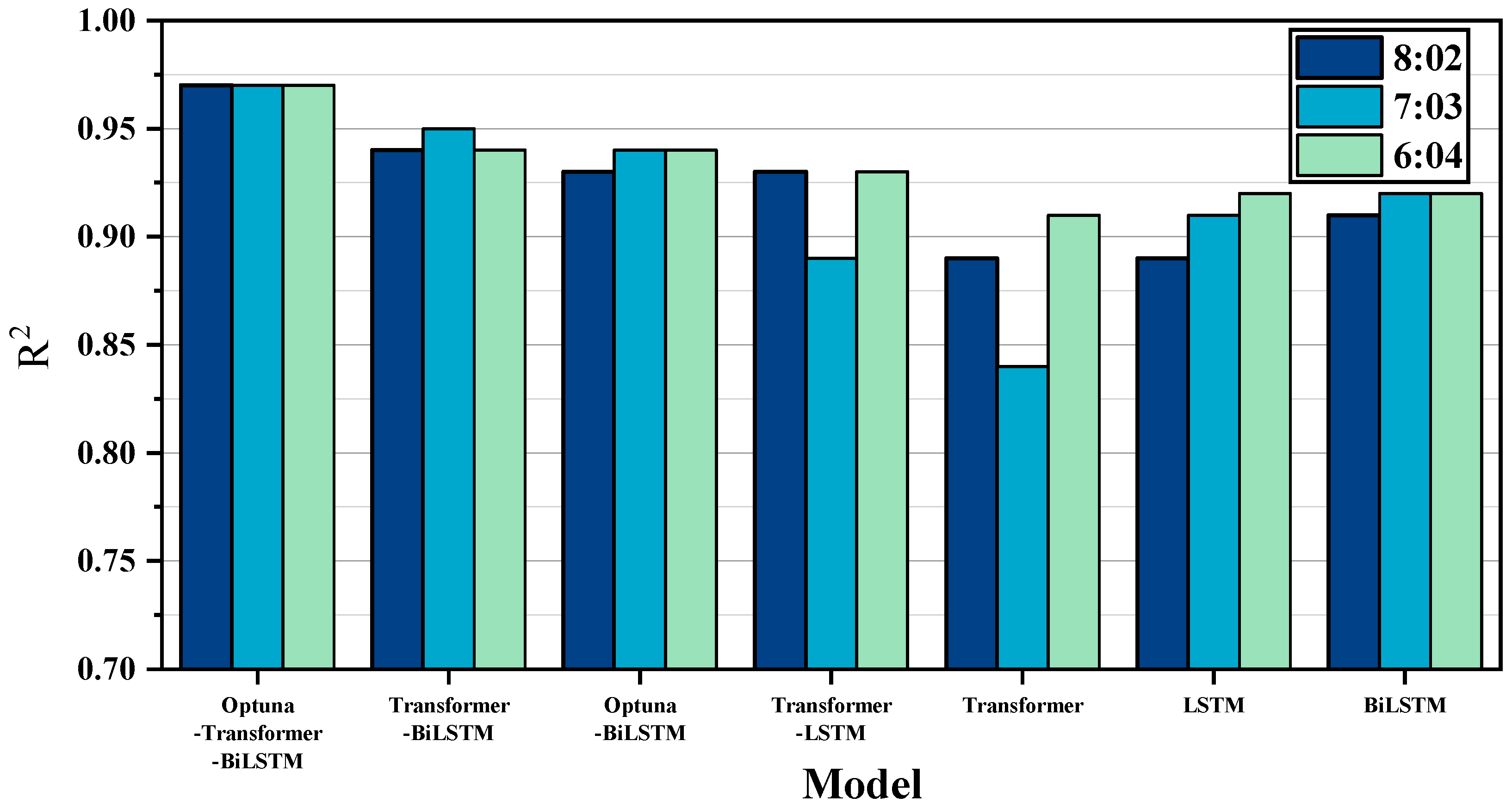
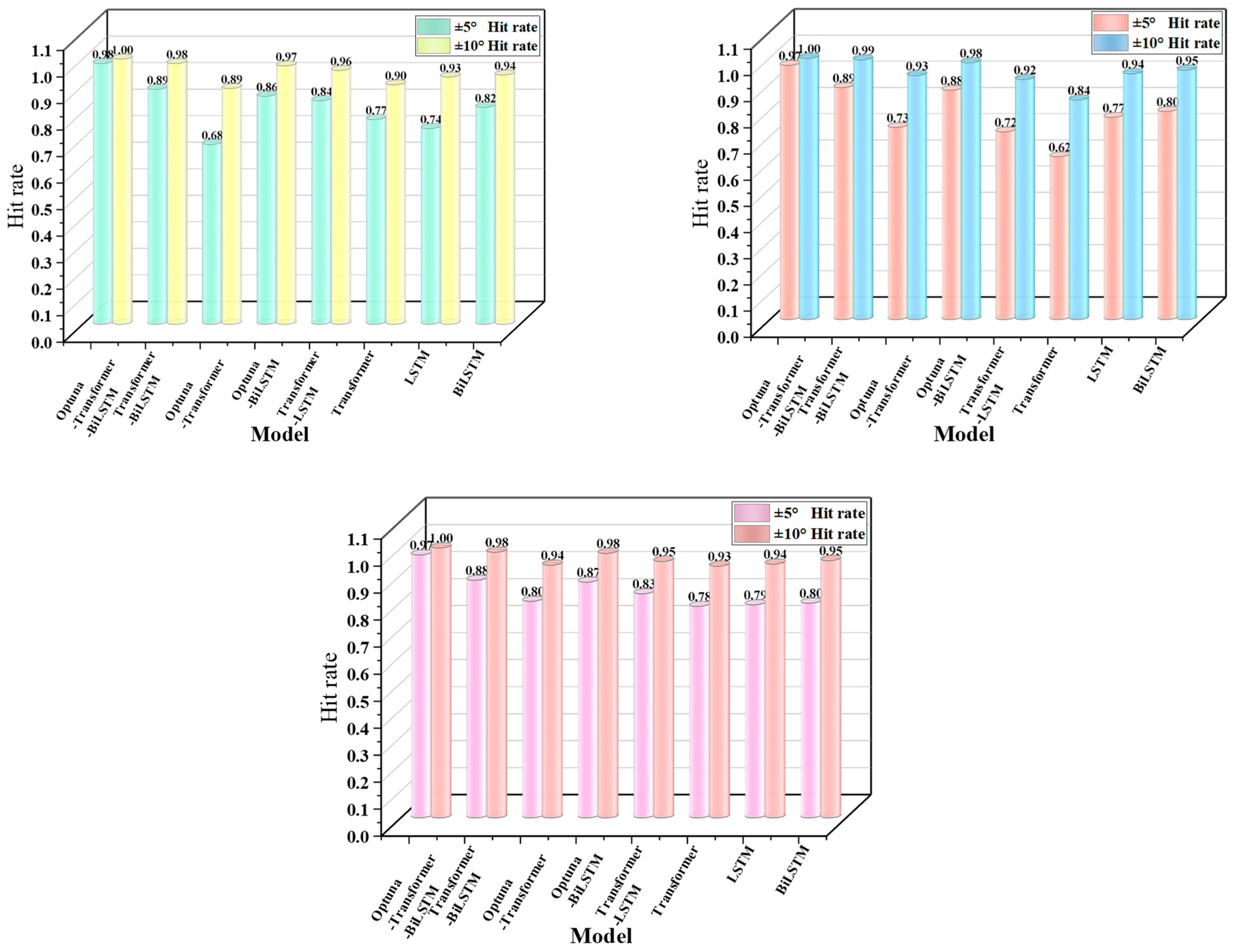
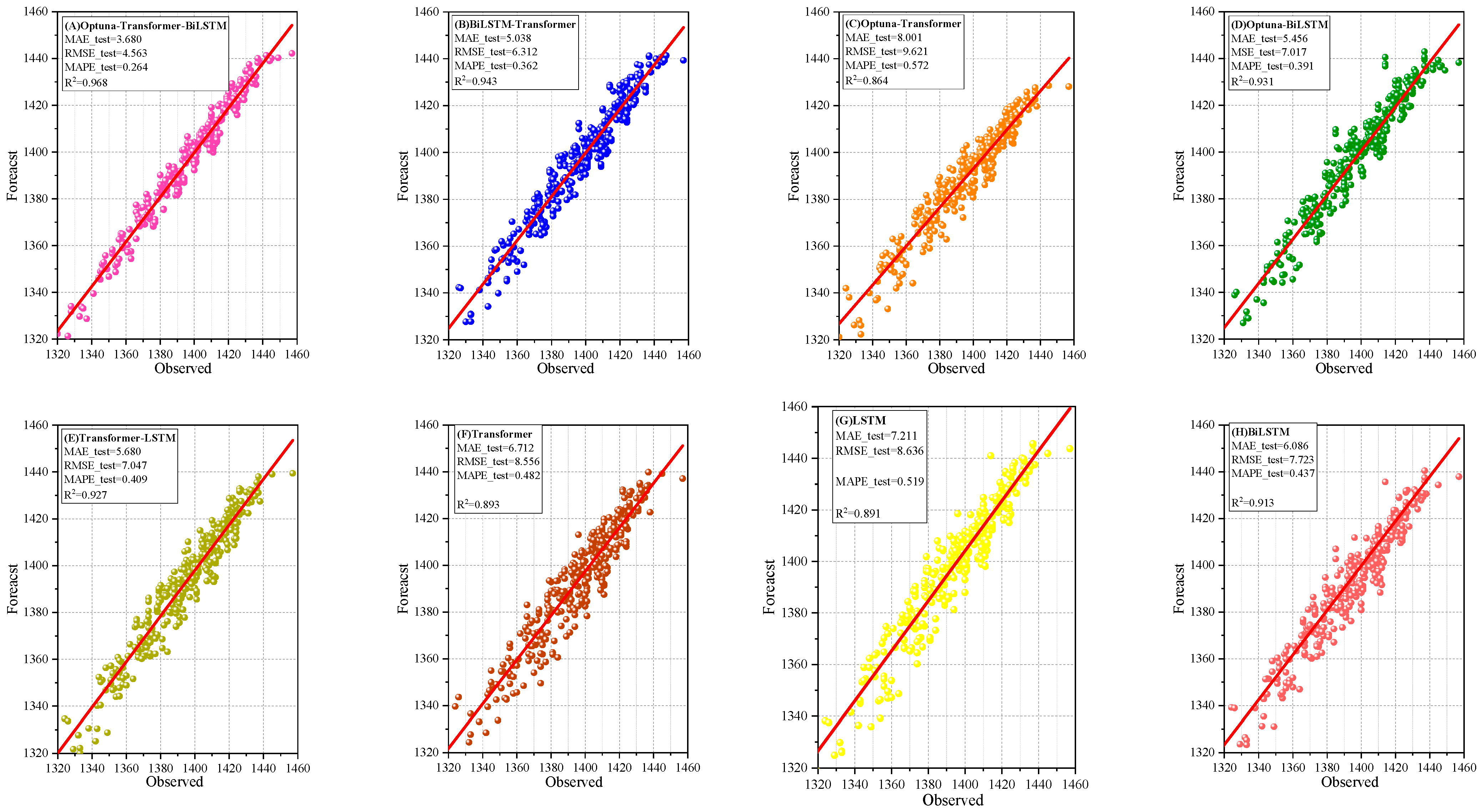
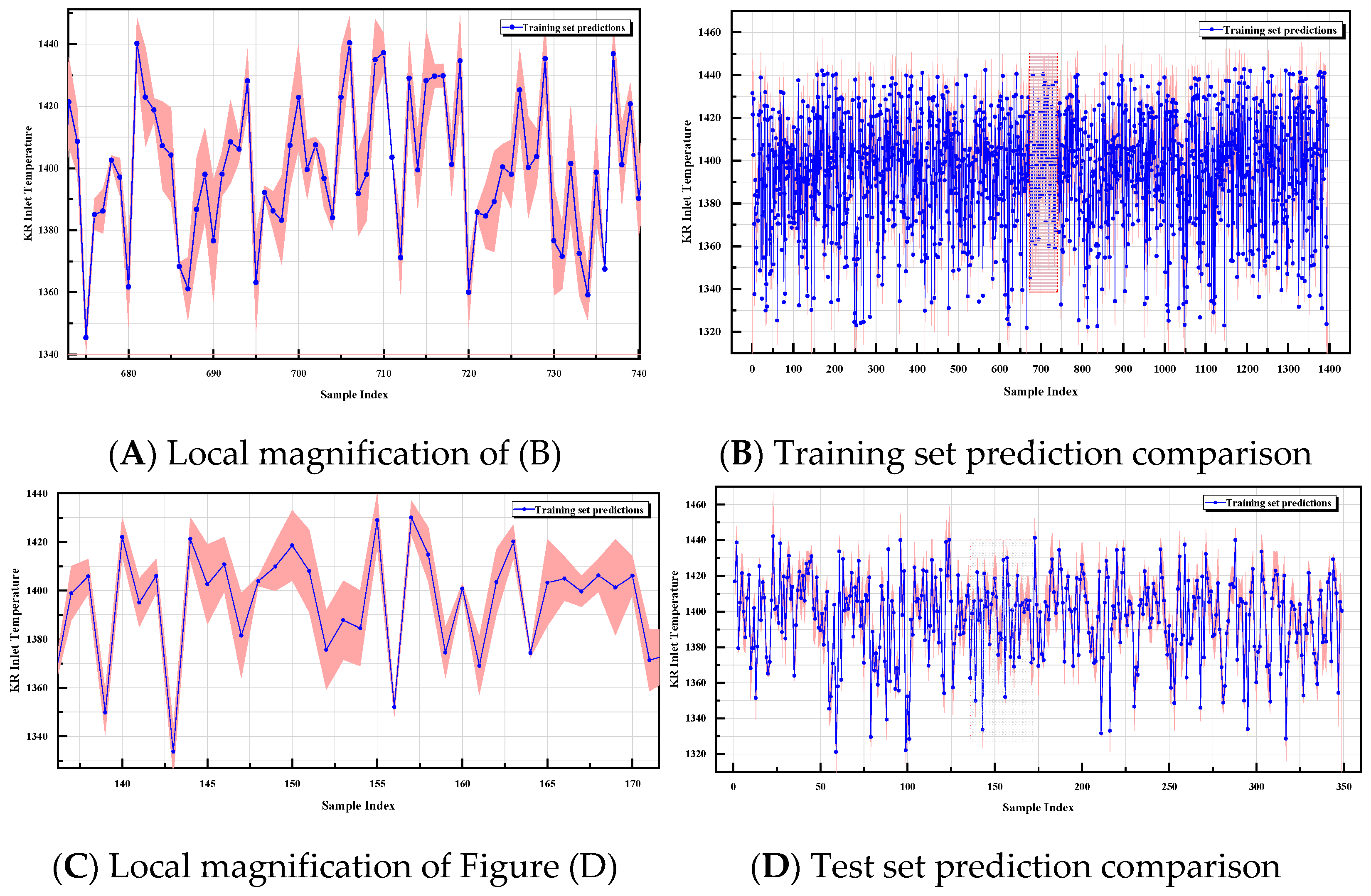
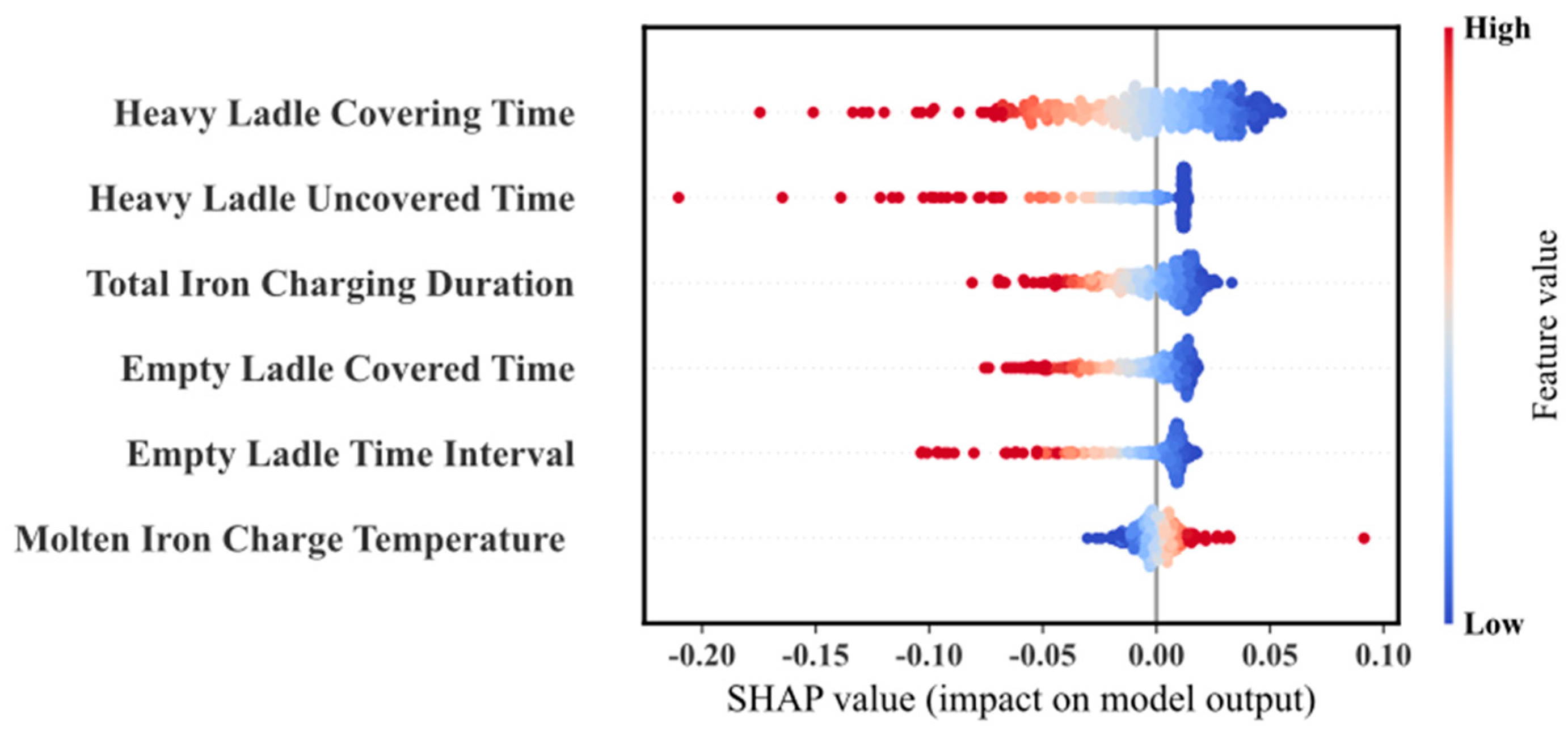
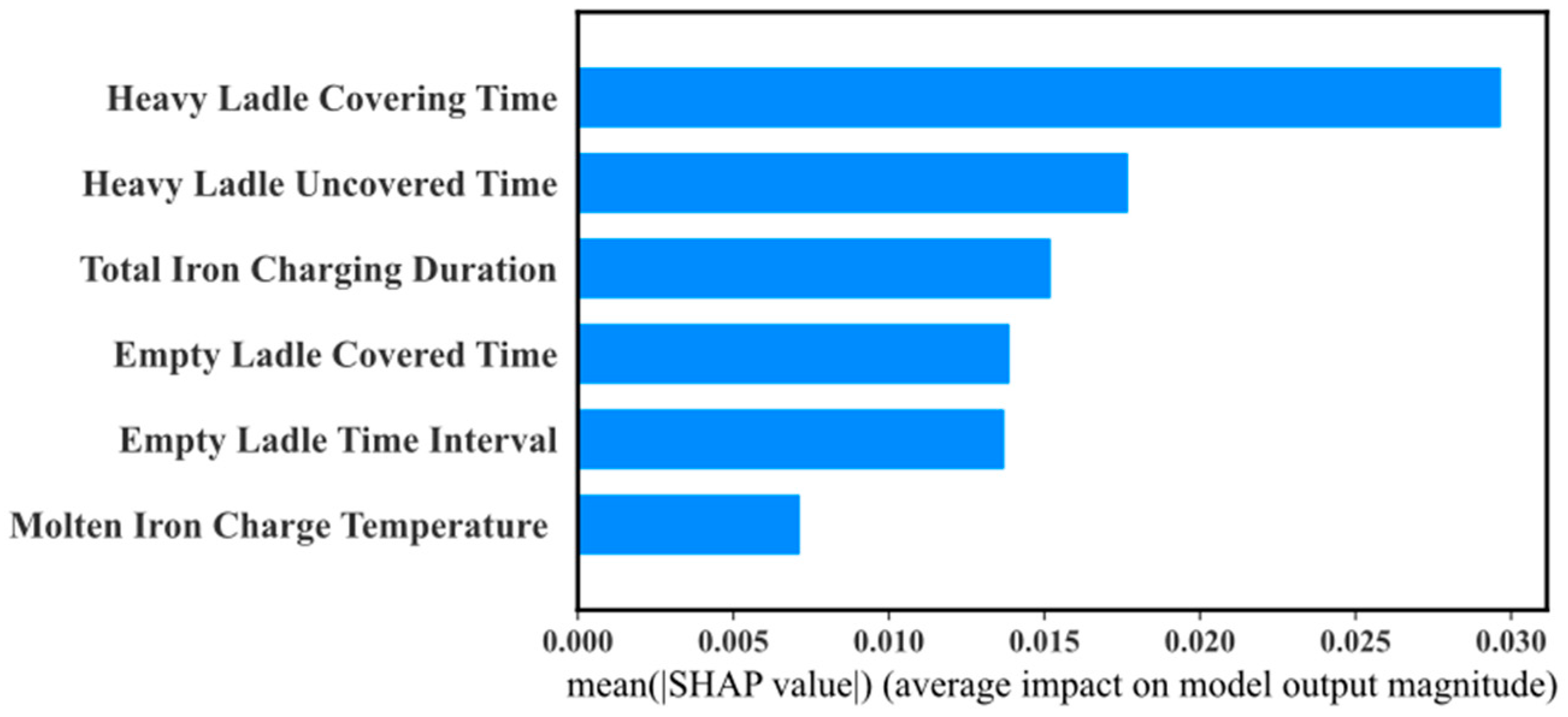
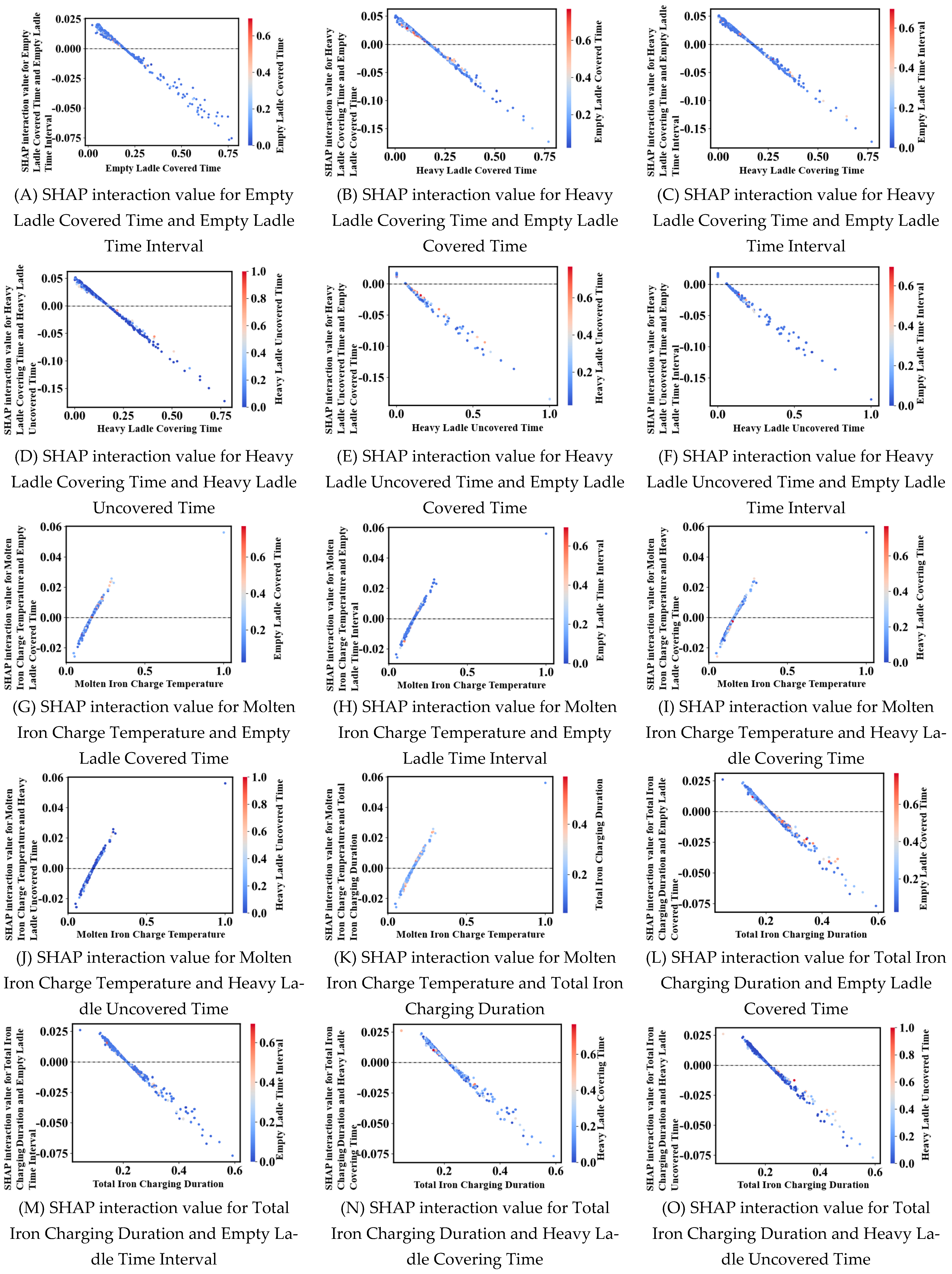

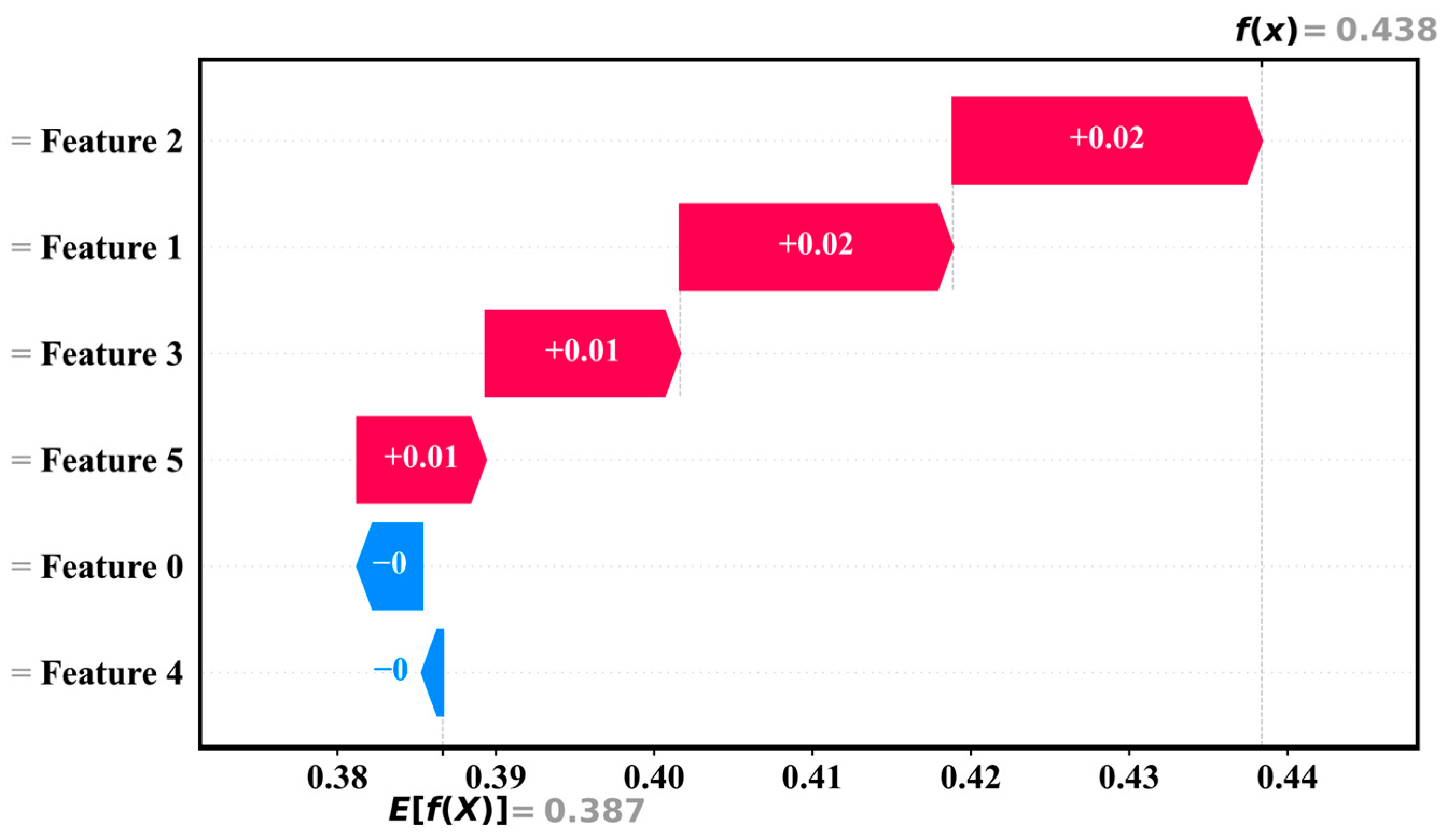
| Parameters | Optimal Choice | Describe |
|---|---|---|
| Feature Window Size | 20 | Refers to the size of the window in the input data used for model training |
| Number of LSTM Units | 128 | The number of neurons per LSTM layer. |
| Embedding Dimension | 64 | The representation dimension of the data in the embedding layer determines the size of the feature vector. |
| Number of Heads in the Multi-Head Attention Mechanism | 8 | The number of heads in the bull attention mechanism |
| Model | Dataset Split | Data | R2 | Rmse | Mae | Mape | ±5° Hit Rate | ±10° Hit Rate | ±15° Hit Rate |
|---|---|---|---|---|---|---|---|---|---|
| Optuna-Transformer-Bi-LSTM | 8:2 | Train | 0.967 | 4.979 | 3.976 | 0.285 | 0.677 | 0.968 | 0.999 |
| Test | 0.968 | 4.563 | 3.680 | 0.264 | 0.696 | 0.983 | 1.000 | ||
| 7:3 | Train | 0.968 | 4.894 | 3.881 | 0.278 | 0.699 | 0.970 | 0.998 | |
| Test | 0.967 | 4.735 | 3.802 | 0.273 | 0.698 | 0.971 | 0.998 | ||
| 6:4 | Train | 0.966 | 5.017 | 3.982 | 0.285 | 0.682 | 0.965 | 0.999 | |
| Test | 0.969 | 4.700 | 3.767 | 0.271 | 0.696 | 0.974 | 1.000 | ||
| Transformer-Bi-LSTM | 8:2 | Train | 0.947 | 6.393 | 5.019 | 0.361 | 0.580 | 0.882 | 0.981 |
| Test | 0.943 | 6.312 | 5.038 | 0.362 | 0.541 | 0.886 | 0.983 | ||
| 7:3 | Train | 0.948 | 6.306 | 4.930 | 0.354 | 0.583 | 0.892 | 0.983 | |
| Test | 0.948 | 6.190 | 4.934 | 0.354 | 0.561 | 0.886 | 0.992 | ||
| 6:4 | Train | 0.945 | 6.546 | 5.115 | 0.367 | 0.572 | 0.871 | 0.980 | |
| Test | 0.944 | 6.425 | 5.076 | 0.365 | 0.566 | 0.880 | 0.984 | ||
| Optuna-Transformer | 8:2 | Train | 0.872 | 10.031 | 8.308 | 0.593 | 0.331 | 0.644 | 0.869 |
| Test | 0.864 | 9.621 | 8.001 | 0.572 | 0.339 | 0.678 | 0.889 | ||
| 7:3 | Train | 0.920 | 7.953 | 6.401 | 0.459 | 0.463 | 0.783 | 0.952 | |
| Test | 0.896 | 8.588 | 7.236 | 0.520 | 0.366 | 0.734 | 0.932 | ||
| 6:4 | Train | 0.931 | 7.336 | 5.769 | 0.415 | 0.525 | 0.839 | 0.951 | |
| Test | 0.919 | 7.732 | 6.006 | 0.432 | 0.507 | 0.802 | 0.936 | ||
| Optuna-Bi-LSTM | 8:2 | Train | 0.937 | 6.923 | 5.384 | 0.387 | 0.546 | 0.871 | 0.967 |
| Test | 0.931 | 7.017 | 5.456 | 0.391 | 0.561 | 0.860 | 0.974 | ||
| 7:3 | Train | 0.935 | 7.045 | 5.429 | 0.390 | 0.544 | 0.866 | 0.963 | |
| Test | 0.939 | 6.696 | 5.326 | 0.383 | 0.561 | 0.876 | 0.981 | ||
| 6:4 | Train | 0.934 | 7.124 | 5.486 | 0.394 | 0.538 | 0.867 | 0.961 | |
| Test | 0.940 | 6.660 | 5.266 | 0.379 | 0.566 | 0.873 | 0.980 | ||
| Transformer-LSTM | 8:2 | Train | 0.932 | 7.298 | 5.836 | 0.419 | 0.498 | 0.833 | 0.967 |
| Test | 0.927 | 7.047 | 5.680 | 0.409 | 0.516 | 0.843 | 0.957 | ||
| 7:3 | Train | 0.907 | 8.583 | 6.892 | 0.495 | 0.430 | 0.742 | 0.933 | |
| Test | 0.886 | 9.021 | 7.462 | 0.536 | 0.380 | 0.717 | 0.917 | ||
| 6:4 | Train | 0.938 | 6.990 | 5.510 | 0.396 | 0.540 | 0.851 | 0.968 | |
| Test | 0.925 | 7.413 | 5.895 | 0.424 | 0.506 | 0.830 | 0.950 | ||
| Transformer | 8:2 | Train | 0.912 | 8.320 | 6.618 | 0.475 | 0.453 | 0.769 | 0.932 |
| Test | 0.893 | 8.556 | 6.712 | 0.482 | 0.467 | 0.772 | 0.903 | ||
| 7:3 | Train | 0.849 | 10.923 | 9.055 | 0.648 | 0.300 | 0.600 | 0.818 | |
| Test | 0.842 | 10.588 | 8.715 | 0.624 | 0.321 | 0.622 | 0.839 | ||
| 6:4 | Train | 0.923 | 7.777 | 6.109 | 0.440 | 0.490 | 0.825 | 0.951 | |
| Test | 0.907 | 8.269 | 6.519 | 0.470 | 0.462 | 0.783 | 0.932 | ||
| LSTM | 8:2 | Train | 0.907 | 8.565 | 6.754 | 0.486 | 0.447 | 0.756 | 0.925 |
| Test | 0.891 | 8.636 | 7.211 | 0.519 | 0.387 | 0.738 | 0.932 | ||
| 7:3 | Train | 0.909 | 8.497 | 6.765 | 0.485 | 0.443 | 0.759 | 0.920 | |
| Test | 0.910 | 7.983 | 6.430 | 0.462 | 0.480 | 0.772 | 0.939 | ||
| 6:4 | Train | 0.916 | 8.131 | 6.360 | 0.457 | 0.496 | 0.791 | 0.935 | |
| Test | 0.915 | 7.931 | 6.201 | 0.446 | 0.496 | 0.789 | 0.940 | ||
| Bi-LSTM | 8:2 | Train | 0.921 | 7.880 | 6.225 | 0.446 | 0.492 | 0.792 | 0.950 |
| Test | 0.913 | 7.723 | 6.086 | 0.437 | 0.493 | 0.818 | 0.940 | ||
| 7:3 | Train | 0.921 | 7.883 | 6.197 | 0.444 | 0.495 | 0.798 | 0.946 | |
| Test | 0.915 | 7.768 | 6.198 | 0.445 | 0.486 | 0.795 | 0.953 | ||
| 6:4 | Test | 0.921 | 7.876 | 6.168 | 0.442 | 0.502 | 0.798 | 0.945 | |
| Train | 0.917 | 7.808 | 6.242 | 0.448 | 0.477 | 0.795 | 0.953 |
Disclaimer/Publisher’s Note: The statements, opinions and data contained in all publications are solely those of the individual author(s) and contributor(s) and not of MDPI and/or the editor(s). MDPI and/or the editor(s) disclaim responsibility for any injury to people or property resulting from any ideas, methods, instructions or products referred to in the content. |
© 2025 by the authors. Licensee MDPI, Basel, Switzerland. This article is an open access article distributed under the terms and conditions of the Creative Commons Attribution (CC BY) license (https://creativecommons.org/licenses/by/4.0/).
Share and Cite
Shen, Z.; Han, W.; Hu, Y.; Zhu, Y.; Han, J. An Interpretable Hybrid Deep Learning Model for Molten Iron Temperature Prediction at the Iron-Steel Interface Based on Bi-LSTM and Transformer. Mathematics 2025, 13, 975. https://doi.org/10.3390/math13060975
Shen Z, Han W, Hu Y, Zhu Y, Han J. An Interpretable Hybrid Deep Learning Model for Molten Iron Temperature Prediction at the Iron-Steel Interface Based on Bi-LSTM and Transformer. Mathematics. 2025; 13(6):975. https://doi.org/10.3390/math13060975
Chicago/Turabian StyleShen, Zhenzhong, Weigang Han, Yanzhuo Hu, Ye Zhu, and Jingjing Han. 2025. "An Interpretable Hybrid Deep Learning Model for Molten Iron Temperature Prediction at the Iron-Steel Interface Based on Bi-LSTM and Transformer" Mathematics 13, no. 6: 975. https://doi.org/10.3390/math13060975
APA StyleShen, Z., Han, W., Hu, Y., Zhu, Y., & Han, J. (2025). An Interpretable Hybrid Deep Learning Model for Molten Iron Temperature Prediction at the Iron-Steel Interface Based on Bi-LSTM and Transformer. Mathematics, 13(6), 975. https://doi.org/10.3390/math13060975






